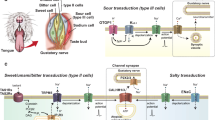Abstract
THE amiloride-sensitive epithelial sodium channel constitutes the rate-limiting step for sodium reabsorption in epithelial cells that line the distal part of the renal tubule, the distal colon, the duct of several exocrine glands, and the lung. The activity of this channel is upregulated by vasopressin and aldosterone, hormones involved in the maintenance of sodium balance, blood volume and blood pressure1,2. We have identified the primary structure of the α-subunit of the rat epithelial sodium channel by expression cloning in Xenopus laevis oocytes3. An identical subunit has recently been reported4. Here we identify two other subunits (β and γ) by functional complementation of the α-subunit of the rat epithelial Na+ channel. The ion-selective permeability, the gating properties and the pharmacological profile of the channel formed by coexpressing the three subunits in oocytes are similar to that of the native channel.
Similar content being viewed by others
References
Palmer, L. G. A. Rev. Physiol. 54, 51–66 (1992).
Rossier, B. C. & Palmer, L. G. The Kidney, Physiology and Pathophysiology (eds Seldin, D. W. & Giebiesch, G.) 1373–1409 (Raven, New York, 1992).
Canessa, C. M., Horisberger, J. D. & Rossier, B. C. Nature 361, 467–470 (1993).
Lingueglia, E., Voilley, N., Waldmann, R., Lazdunski, M. & Barbry, P. FEBS Lett. 318, 95–99 (1993).
Kemendy, A. E., Kleyman, T. R. & Eaton, D. C. Am. J. Physiol. 263, C825–C837 (1992).
Palmer, L. G. & Frindt, G. Proc. natn. Acad. Sci. U.S.A. 83, 2767–2770 (1986).
Catterall, W. A. Physiol. Rev. 72 (suppl.), S15–S48 (1993).
Garty, H. & Benos, D. J. Physiol. Rev. 68, 309–372 (1988).
Driscoll, M. & Chalfie, M. Trends Neurosci. 15, 15–19 (1992).
Chalfie, M., Driscoll, M. & Huang, M. X. Nature 361, 504 (1993).
Canessa, C. M., Merillat, A-M., Horisberger, J-D. & Rossier, B. C. J. Am. Soc. Nephrol. 4, 864 (abstr.) (1993).
Pongs, O. Physiol. Rev. 72 (suppl.), S69–S88 (1992).
Unwin, N. Cell 10 (suppl.) 31–41 (1993).
Benos, D. J., Saccomani, G. & Sariban-Sohraby, S. J. biol. Chem. 262, 10613–10618 (1987).
Sariban-Sohraby, S., Abramow, M. & Fisher, R. S. Am. J. Physiol. 263, C1111–C1117 (1992).
Cuthbert, A. W. J. Roy. Soc. Med. 85 (suppl.), 2–5 (1992).
Ausiello, D. A., Stow, J., Cantiello, H. F., de Almeida, J. B. & Benos, D.J. J. biol. Chem. 267, 4759–4765 (1992).
Staub, O. et al. J. Cell Biol. 119, 1497–1506 (1992).
Barbry, P. et al. Proc. natn. Acad. Sci. U.S.A. 87, 7347–7351 (1990).
Prat, A. G., Bertorello, A. M., Ausiello, D. A. & Cantiello, D. A. Am. J. Physiol. 265, C224–C233 (1993).
Martinac, B., Buechner, M., Delcour, A. H., Adler, J. & Kung, C. Proc. natn. Acad. Sci. U.S.A. 84, 2297–2301 (1987).
Gustin, M. C., Zhou, X. L., Martinac, B. & Kung, C. Science 242, 762–765 (1988).
Guharay, F. & Sachs, F. J. Physiol., Lond. 352, 685–701 (1984).
Hudspeth, A. J. Hearing Res. 22, 21–27 (1986).
Ohmori, H. J. Physiol., Lond. 350, 561–581 (1984).
Jorgensen, F. & Ohmori, H. J. Physiol., Lond. 403, 577–588 (1988).
Vigne, P. et al. J. biol. Chem. 264, 7663–7668 (1989).
Van Renterghem, C. & Lazdunski, M. Pflügers Arch. 419, 401–408 (1991).
Taglietti, V. & Toselli, M. J. Physiol., Lond. 407, 311–328 (1988).
Bear, C. Am. J. Physiol. 258, C421–C428 (1990).
Hong, K. & Driscoll, M. Nature 367, 470–473 (1994).
Huang, M. & Chalfie, M. Nature 367, 467–470 (1994).
Palmer, L. G., Corthésy-Theulaz, I., Gaeggeler, H. P., Kraehenbuhl, J. P. & Rossier, B. C. J. gen. Physiol. 96, 23–46 (1990).
Author information
Authors and Affiliations
Rights and permissions
About this article
Cite this article
Canessa, C., Schild, L., Buell, G. et al. Amiloride-sensitive epithelial Na+ channel is made of three homologous subunits. Nature 367, 463–467 (1994). https://doi.org/10.1038/367463a0
Received:
Accepted:
Issue Date:
DOI: https://doi.org/10.1038/367463a0
- Springer Nature Limited
This article is cited by
-
Comprehensive mapping of Epithelial Na+ channel α expression in the mouse brain
Brain Structure and Function (2024)
-
Salt Taste and Salt Sensitive Hypertension in HIV
Current Hypertension Reports (2023)
-
Molecular logic of salt taste reception in special reference to transmembrane channel-like 4 (TMC4)
The Journal of Physiological Sciences (2022)
-
Two adjacent phosphorylation sites in the C-terminus of the channel’s α-subunit have opposing effects on epithelial sodium channel (ENaC) activity
Pflügers Archiv - European Journal of Physiology (2022)
-
Low-salt diet increases mRNA expression of aldosterone-regulated transporters in the intermediate portion of the endolymphatic sac
Pflügers Archiv - European Journal of Physiology (2022)





